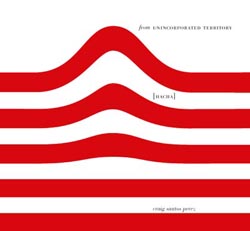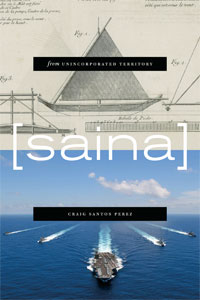'I'm here to testify about the fangs of militarization ... '
A chronicle of Craig Santos Perez's metaphor

Kaia Sand
Until this spring, I assumed a chronology that was backward. I had thought that it was during his testimony before the United Nations that Craig Santos Perez developed his metaphor connecting the brown tree snake–an invasive species on Guam–to the military presence on Guam.
 No, he explained as we chatted in Portland this past March during his poetry-reading stop-off, he had worked out the metaphor in his poetry, and then realized that it would be memorable in his testimony.
No, he explained as we chatted in Portland this past March during his poetry-reading stop-off, he had worked out the metaphor in his poetry, and then realized that it would be memorable in his testimony.
He brought his poetic skills to bear in his activist work.
I think I had him pour over the sequence of events--how the brown tree snake metaphor traveled into activist circles--twice during his visit, at least. Then he obliged my interest in archiving this by writing it down in what is now an unpublished essay, “Dispersal Pathways: Imagining, Circulating, and Recasting Political and Poetic Images.”
He describes how, as he finished from Unincorporated Territories [hacha] (Tinfish Press 2008), he added a page at the end with an allusion to a U.S. military build-up in Guam, printing an enormous "8000" on a page.  This page followed his sequence "from Descending Plumeria," which, along the top, is an elegy for a beloved cousin, and, along the bottom, describes the invasion of the brown tree snake.
This page followed his sequence "from Descending Plumeria," which, along the top, is an elegy for a beloved cousin, and, along the bottom, describes the invasion of the brown tree snake.
“In my imagination, I equated the incoming of U.S. military personnel with the snakes: both were invasive species,” writes Perez in “Dispersal Pathways.” “Analogy by juxtaposition.”
It was during the reading tour for his first poetry book that he prepared his testimony on the harmful environmental and cultural impacts of militarization on Guam to the United Nations Special Committee on Decolonization. Given only five minutes to present, Perez turned to his “training as poet … because [he] knew how to condense.” He knew he needed an image to make the facts memorable.
During one book reading on his simultaneous tour, he turned back to “from descending plumeria,” the poem in which the snakes appear, a poem he rarely read because he was “emotionally difficult” for him to do so. Looking back, he realizes “the poem called to me during that time.”
Now he had his image for the UN testimony: the brown tree snake.
Standing before the committee, Perez said “I’m here to testify about the fangs of militarization and colonialism destroying the Chamoru people of Guam.” Pause. “These fangs dig deep.”
Perez went on to describe how brown tree snakes entered Guam in US Naval Cargo ships during World War II, and then he extended the metaphor, describing the military as “a more familiar breed of predators.” He described how the military has polluted Guam’s environment, sickening people, by extending the metaphor more: “Toxic chemicals have snaked into our bloodstream.”
He ended the testimony this way: “And even though powerful snakes block our passage, we are willing to struggle for our rights—but we need your help.”
The metaphor was memorable. The UN highlighted it in its press release about the meetings. Perez’s testimony was compiled with others from Chamoru activists into a pamphlet called Hita Guahan and “distributed at various activist and cultural events in Guam, Hawaii, and the continental United States…. and distributed via email, listserves, and blogs.”
“Our testimonies began to circulate further through various online news networks in the Pacific and the United States,” writes Perez, including Scoop News, out of New Zealand, a decolonization weblog Perez sites in his first book, and the Chamorro activist magazine, Minagahet Zine.
Perez also points out an Oct 2010 article on the Time Magazine website, “Guam: An Early Casualty of U.S. China relations?” that begins by describing the introduction and damage of the Brown Tree Snake, and then moves to this sentence, “Now Guam is getting ready for a new invasive species to come ashore: the U.S. Marines. At least, that's how some of Guam's 178,000 residents see it.”
The online encyclopedia Guampedia includes an entry on “Kulepbla: Snakes” written by Chamoru poet, activist, professor, and UN testifier, Michael Lujan Bevacqua, that also links the brown tree snake to the US military presence, and lists Perez’s UN testimony as “further reading.”
“While my testimony has circulated in all these different spaces because of its political and rhetorical content, the source of one of its guiding metaphors was a moment of poetry,” writes Perez. “And while my first poetry book will likely not be referenced or cited in the same way, it is still the origin of that image in my imagination.”
My initial assumption that Perez first developed the metaphor in his testimony might be based in the fact that there is so much circulation between his activism and his poetry. He brought the testimony back into his poetry, handing out Hita Guahan at poetry readings, posting his UN testimony at the Harriet Blog, and, remixing the testimony into both his second and forthcoming third books. 
Last year, the Konsehilon Tinaotao Guam (Guam Humanities Council) invited Perez to engage community conversations around the military build-up in his capacity as both poet and activist. In a week, he estimates he engaged “nearly 500 students and 300 community members” in addition to appearing on local media.
“I think back to the moment in 2006 when I typed “8,000?*” into my poem,” he writes. “I never would have imagined that four years later I would be flying home for the first time in fifteen years to explore ways that poetry can engage in civic and political conversations.”
works cited
Perez, Craig Santos. “Dispersal Pathways: Imagining, Circulating, and Recasting Political and Poetic Images.” Unpublished Essay, 2011.
Moxie politik